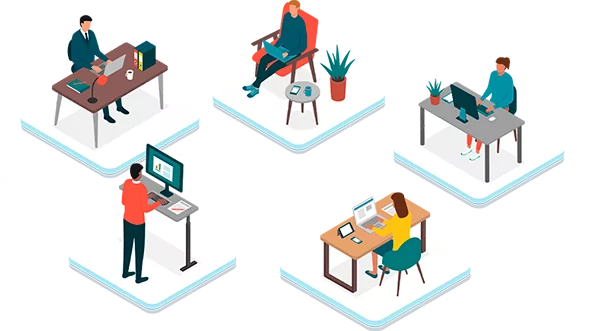Software development has gone through numerous changes in recent years. With 2020 being challenging, many businesses and companies have had to adapt their web and app development process to meet a changing market’s needs and user experience.
If the last year has taught us anything, it is to prepare for the unexpected. So what does the future hold for the world of software development, you ask? Our guess – plenty.

What Is The future of the software development industry?
The truth about the future of the software development industry is that it is already here. Software development processes and tooling utilised to facilitate implementation activities are rapidly growing in terms of capabilities and ease of use. Furthermore, programming languages are continuously being extended, introducing innovative and powerful functionality for developers to utilise. These advancements open up new and exciting opportunities for businesses to exploit. The following sections highlight some of the exciting trends that are set to take off within the software development industry.
What Are The Emerging software development trends?
Numerous software improvements are being embraced by industry leaders that will ultimately change the entire software development process going forwards. Generally, innovators can be divided between leading the curve, waiting to adopt the next new thing or the early-flowering majority keen to adopt the latest trends. Innovators at the forefront of these new software evolution processes are interested in:
- Blockchain – A rapidly expanding application of encrypted records that use cryptocurrency.
- AI – Machine learning utilising artificial intelligence within the program construction process.
- Deep Learning – An extension of artificial intelligence technology that uses a collection of neural networks.
Those waiting to employ the next big thing are primarily focusing on:
- Business Process Orchestration – A cross-platform cloud-computing software management system.
- Lambada/ Serverless – An approach to computing which focuses on building serverless apps.
- Graph QL – Intended for APIs, this is an open-source language for data manipulation.
- Reactive Programming – Software programs that allow for multiple simultaneous data reading.
Innovators who are keen to adopt these emerging trends are focusing on:
- Immutable Infrastructure – A management approach to simplify software development deployments.
- Microservices – A method of dividing an app into smaller independent, but related services.
- Lean – Transfering Lean manufacturing principles into a the domain of software development (e.g. Agile programming).
- API Design – Application Programming Interfaces that segment applications into smaller more manageable components with a clear separation of concerns.
These software improvement trends vary massively but share one distinct similarity – they all help industries open up new doors of possibilities for the future by creating cleaner, more robust and easier to maintain applications.
NVIDIA is an example of a company utilising the above technological advancements (e.g. AI, deep learning, lean, API, etc) to create chipsets that facilitate autonomous driving vehicles. This would never have been possible just decades prior and hinges entirely on companies embracing these emerging software improvement trends.

Need Expert Guidance?
We provide fully managed end-to-end solutions for operators and service companies needing expert guidance.
Take advantage of our unique {SD:UK} CTO as a Service solution. Our experts help you to formally capture requirements, create a system specification and then fully manage the implementation of your project for a successfull delivery.


What Technologies Are At The Cutting Edge?
As with all new and innovative trends, the real action is happening at the cutting-edge. Below is a selection of the most cutting-edge software improvement areas that astute organisations should keep a watchful eye on to stay ahead of the trends.
Artificial Intelligence (AI)
The landscape of software development is being reshaped by the meteoric rise of artificial intelligence (AI). As AI continues to mature, its influence on software development is becoming more profound, transforming how we conceptualise, design, and implement software solutions.
One of the key areas where AI is making a significant impact is in the integration of deep learning algorithms into software projects. With the advent of sophisticated tools from industry pioneers like OpenAI, DeepMind, and Nvidia, what was once an expensive and complex endeavour is now becoming increasingly accessible and cost-effective. These tools have democratised access to advanced AI capabilities, allowing developers to harness the power of AI and deep learning without needing extensive domain knowledge. As a result, software projects are becoming smarter, more responsive, and increasingly efficient.
Beyond the integration of AI into applications, AI is also revolutionising the software development process itself. Developers are increasingly leveraging AI to automate portions of the coding process, reducing the time taken to write software and improving efficiency. AI-driven code completion tools, for instance, can predict and auto-fill parts of code, enabling developers to code faster with fewer errors. Moreover, AI-powered bug detection tools can spot errors and vulnerabilities that might escape human eyes, enhancing the security and reliability of the software.
But AI’s potential goes even further, promising a future where AI could generate entire software applications from a simple verbal or written command. This not only accelerates the software development process but also makes it more accessible to non-technical individuals, enabling them to create custom software solutions without writing a single line of code.
As we look towards the future, it’s clear that AI is not just a trend; it’s a transformative force that’s redefining the very fabric of software development. By embracing these technologies, developers and businesses alike can unlock new levels of efficiency, innovation, and competitive advantage.
Machine Learning
Another software development trend that we expect to boom in the next few years is machine learning (a subset of artificial intelligence). There are already many applications utilising machine learning to make decisions based on previous information or real-time information. Voice-assistant technologies, such as Google Home or Amazon’s Alexa – are just examples of when industry-leading companies have invested heavily into machine learning technologies to great success.
As machine learning apps make decisions based on previous information that it stores and ‘learns’ from, the more this form of technology is used, the better (and faster) it will become. Software development companies with that have their finger on the pulse cannot afford to overlook the role that machine learning is likely to play in all software development trends in the future.
Software Testing issues
When the development of a project is tested within a controlled environment, the results are not always qualitative or useful. This is because it is difficult to assess how a user will interact with the project in a natural and realistic environment and can lead to functionality issues going unnoticed until the end of a plan’s development. As B2B and B2C businesses are becoming increasingly versatile, it is more important than ever that products, software or applications are tested within real-life scenarios throughout the development process.
Blockchain
Fundamentally, blockchain technology creates a secure, decentralised, immutable database or record of all transactions in sequential order (a digital ledger). Each time a transaction is carried out through blockchain technology, it requires the distributed network to validate the transaction request and authorise – this methodology ensures all information contained within the blockchain is correct. Adding a security level and transparency to transactions rarely found elsewhere makes handling business transactions far easier for all parties involved.
2021 will see a massive surge in the number of different cryptocurrencies created. The vast majority of cryptocurrencies will have one (or more) companion end-user software applications that utilise it as an internal currency to purchase/trade assets. Software houses that have proven understanding of blockchain technologies will be highly sought after in 2021.
One of the most highly anticipated crypto developments set for 2021 is Facebook’s launch of their Bitcoin-inspired cryptocurrency, which is likely to increase the amount of consumer engagement and interest around cryptocurrencies as a whole.
Cloud Centralisation
Almost all businesses and enterprises have felt the impact of the Covid-19 pandemic. The one, and main exception, being cloud services – which flourished more than ever throughout the pandemic. The Covid-19 pandemic has brought the value and necessity of having information stored within a cloud environment to the forefront of most consumers.
Without question, Amazon, Google and Microsoft are today’s leading cloud provider companies. However, there is no doubt that 2021 will bring about a surge in migrations towards a cloud-based data storage service, which means that there is likely to be a rise in platforms offering cloud storage. It is expected that there will be a growing demand for software development & IT companies to provide cloud migration services and bespoke cloud based solutions.

What Technologies Are Growing in Popularity
No-code Platforms
A no-coding development process allows developers (and non-developers) to build a platform without using any coding. This means that smaller organisations that lack the budget to outsource or hire a team of highly experienced developers can utilise a no-coding development platform to create their own fully functional applications.
The demand for bespoke software is far beyond the capacities that the existing software development community can deliver. However, this does not mean that coding is likely to plateau. Instead, a rise in no-code tools is set to rise in popularity.
Software developers who utilise a no-coding system can empower a far larger workforce with all of the necessary tools required to build a working app. This means that non-developers can step into the traditionally reserved role for coders, allowing for bespoke software to be created faster, to a high level of quality and cheaper.
One of the most recent developments that prove that no coding methods are something to be aware of is Google recently acquiring App Sheet, bringing no code capabilities into the Google cloud.
Coding languages for mobile-development
Ever since the smartphone took the lead as our primary source of information, there has been a steady and consistent rise in the importance of being accessible through a mobile device platform. Historically, Java was the go-to coding language for mobile expansion; however, as the new software development trends emerge, there are now multiple coding languages that developers can utilise.
Staying up to date on the new coding languages for mobile expansion could be critical for software houses looking to stay current and in line with recent trends and fashions.
Automated Software Development
Automation is a growing trend in software development and is predicted to rise massively in its’ application soon. Whenever a developer has a task that needs repeating multiple times, it is common for them to utilise a bot that performs this task. Furthermore, AI (e.g. GPT-3) can learn how to write code itself, meaning the user only has to describe what they want built and the AI will automatically build the system. This is a very interesting branch of AI and will prove to be very useful in the near future. This, in principle, is what automation means in terms of software improvement.
By creating robots that build machines based on previously imputed information, the likelihood of mistakes being made is drastically reduced, as is the time it takes to achieve results. There are few areas that automation does not prove to be a viable and valuable tool for developers. One of the most significant areas in which automation is proving to be a successful tool is in the developmental process’s quality assurance stage.
Serverless Computing
Other software development trends that are growing in popularity include the use of serverless computing. This is essentially a method whereby software engineers have no involvement with the configuration and deployment of code to the server. Traditionally software developers would be required to facilitate the process of deploying their code to the server (cloud), however this new methodology automates. Organisations utilising serverless computing also receive the benefits of their cloud infrastructure being automatically sized/scaled to meet demand.


{IT Outsourcing Done Right!}
Outsourcing is no longer about just saving money, it is a strategic tool for accessing highly qualified experts to compliment your team and accelerate project delivery. The {SD:UK} team has an excellent track record for delivering high quality projects on time and on budget. Reach out to us for a free consultation with one of our experts.

What Technologies Are Starting to be widely adopted
API
With serverless computing and microservice architecture rapidly growing in popularity in recent years, it is increasingly important that these applications can communicate effectively with each other. Here, an API, or Application Programming Interface, plays its’ part by facilitating synchronous communication between the two applications.
The most dominant API technology in 2020 was provided by REST, an established communications standard based upon web technology. In this era it is mandatory that software development companies have a proven understanding of REST API, because inter-process communication between applications is expected.
Data Science
Big Data is the term given to the massive volumes of data that businesses collect (but are unable to process in real-time). Each year businesses produce a massive amount of this crucial data, often catalogued in large and unstructured datasets. Given this data’s sensitive and valuable nature, a data scientist’s responsibility is to examine and organise all of this critical data to form a structured and cohesive set that they can be easily consumed by other systems for further processing. Data scientists are in great demand due to the sheer volume of data being created daily (e.g. through the expansion of IoT devices).
Outsourcing
Outsourcing has grown exponentially in popularity over the last few years and is expected to continue throughout 2021. From a business perspective, the benefits of outsourcing specific tasks to professional agencies who specialise in them – rather than dividing the tasks amongst their existing team members are very apparent.
When businesses outsource software development tasks to professionals, they can guarantee that they will get the best possible results within a clearly defined timescale. While there are sometimes financial savings to be made from handling all software tasks internally, outsourcing can free up developers from tedious and time-consuming tasks and focus on achieving the project’s larger goals or objectives.
Progressive Web-Apps
Progressive web apps are different from traditional mobile apps, as they can fluctuate between mobile, table and desktop computer devices. This means that companies no longer have to exert time and effort into making a mobile-friendly version of their app, as a PWA allows their app to function across multiple platforms.
With more people than ever using mobile devices to interact and consume, developing a PWA can be an ideal way of creating something accessible to as many users as possible – without sacrificing functionality or aesthetics.
How software companies can use new trends
Software developers must keep in line with the most recent improvement trends to stay ahead of the curve in a forever-evolving industry. There are two tips that should be considered:
Improve their skills
As cutting-edge computing software is continually updated and refined, software developer skills must be updated and refined accordingly. Using new and emerging trends within the field of software development can be one of the most effective ways of doing this. It forces developers outside of their comfort zone and requires them to develop and improve their skills to adapt to new changes.
Get ahead of the competition
For a software developer to be successful, they have to stay one step ahead of the competition. By keeping up to date with all new software development trends, a software developer can ensure that they can provide clients with unparalleled service.
With the number of working software developers set to rise tenfold in coming years, it is more vital than ever that developers can offer clients the latest software development trends and cutting edge computing capabilities, so they are able to stand out in an already saturated market.
Three predictions for the future of software development
The AI revolution is coming
AI is getting better and better at an exponential rate. One of the main predictions for software development in 2021 is a rise in the applications and widespread availability of AI technologies in all manner of functions – from image recognition to advanced machine learning.
Growth in the demand for highly skilled developers
More businesses than ever before are moving into a digital space, and this migration cannot correctly be achieved without a good team of experienced developers. With outsourcing on the rise across the board, another prediction for the future of software advancement in 2021 is an increased need for highly skilled developers to match consumer demand.
The importance of cybersecurity will only increase
As with all new and emerging technologies, nothing is perfect – yet -and there are risks and holes in software security that could be breached.
However, with the rise in machine learning and AI, addressing these security concerns is top of the list for many developers. Cybersecurity is improving, and while things may not be perfect at the moment, as advancements continue, we can all look forwards to a safer cyber service in 2021.

